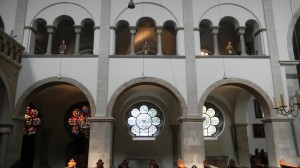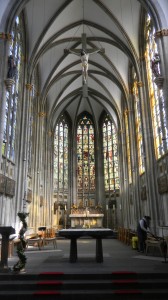Cologne’s Gothic cathedral always gets top billing. Not fair. Cologne’s other medieval churches add up to even more splendor.
Cologne was the largest German city in the Middle Ages. An enormous wall surrounded it, and 12 great Romanesque churches were built. People riding or walking towards Cologne saw the spires glittering over the walls and imagined they were approaching the earthly counterpart of the City of God–the New Jerusalem. Come through the gate.
Cologne had been a prosperous ancient Roman colony. It dominated the trade in the Lower Rhine. Many churches were built there in late Roman times. Cologne again became a major trading city under Archbishop Bruno (954-965). He had a good connection on Earth: his brother, Emperor Otto the Great. Bruno completed Cologne’s garland of churches.
These churches were later added to, and some were combined with Gothic architecture in the 13th century. I legged it to 9, through the city’s busy modern streets. They were worth every step.
We’ll look at one of the most important in this post, the Basilica of Saint Ursula (which graces all three photos here). The growing medieval city formed a lot of its identity around her legend.
Ursula was a daughter of a British Christian king in the 5th century. She asked to postpone a marriage to a pagan prince he arranged for her. With 10 ladies in waiting, she sailed across the sea, and up the Rhine to Basle, Switzerland. They trekked on to Rome. On their way back, invading Huns captured them. The chief insisted that Ursula marry him. She refused, and killed herself.
By the 10th century, this legend grew. 1,000 maidens accompanied each lady in waiting. All were massacred. There’s some truth in the legend–bones of many massacred women were found near the present basilica. But the Church considers much of the story false and removed Ursula from the calendar of Catholic saints.
But the growing town of merchants resonated with this legend. It provided a model of steadfastness for them. They thus continued to beautify the basilica, and their work climaxed in the sublime Gothic style choir that they added (pictured above). You don’t see fancy French forms here, but arrow-straight lines meeting in Heaven–like the pious souls the basilica honors.




Comments on this entry are closed.